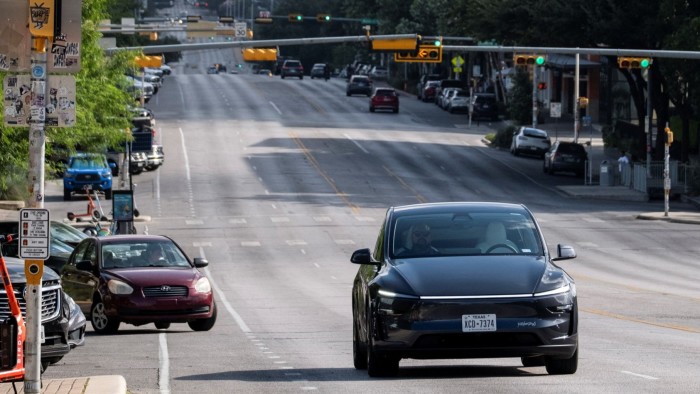Unlock the Editor’s Digest for free
Roula Khalaf, Editor of the FT, selects her favourite stories in this weekly newsletter.
Tesla’s robotaxi service, touted by Elon Musk as the future of his flagging electric-car maker, is expected to launch in the company’s home city of Austin on Sunday with only about 10 cars and a human safety driver on board amid regulatory scrutiny on the safety of its self-driving technology.
Shares in Tesla have risen about 50 per cent from this year’s low in early April, with investors hopeful that the autonomous ride-hailing service will help revive a company that has suffered declining sales and a consumer backlash against Musk’s political activism.
Despite the hype surrounding the service, the launch was low-key and the initial service was open only to a select group of social media influencers.
Shortly before the official launch on Sunday, Musk said on social media that the robotaxi service would begin “with customers paying a $4.20 flat fee”.
According to Musk, who has stepped back from his US government role to focus on Tesla and the robotaxi launch, the self-driving Model Y vehicles will only operate in limited areas, avoid challenging intersections, and have teleoperators who can intervene if problems arise.
The limited launch comes as the National Highway Traffic Safety Administration continues to carry out multiple investigations into Musk’s claims about the capabilities of its autopilot and “full self-driving” systems. Despite its name, FSD still requires humans to sit in the driver’s seat and pay full attention — unlike Google’s Waymo taxis.
The NHTSA wrote a letter in early May seeking additional information about technologies that would be used in Tesla’s robotaxi service. The agency said it had received Tesla’s response and was reviewing its content.
Musk said in a social media post this month that the company was being “super paranoid” about safety. But he has also claimed there would be 1,000 robotaxis “in a few months”, and that the service would expand to cities such as San Francisco and Los Angeles.
On Sunday, Tesla also opened a new website for the public to sign up to get updates on the robotaxis, which can be hailed via an app.
It remains uncertain how fast Tesla will be able to expand its service and catch up with Waymo, the only company with a fully public self-driving ride-hailing service in the US, which rolled out its fleet in San Francisco three years ago.
A group of Democratic lawmakers in Texas wrote to Tesla this week urging the company to delay its robotaxi launch until September when a new law on autonomous vehicles is due to be implemented. State governor Greg Abbott signed the rules — which require a state permit to operate self-driving vehicles — into law on Friday.
Tesla’s technology relies only on a set of cameras mounted on its vehicles, compared with the more expensive set of radar and lidar sensors used by Waymo and other rivals.
Musk claims its approach will allow Tesla to expand the service more quickly and at cheaper prices. Tesla has said its Cybercab, which has no steering wheel or pedals and was unveiled last year, will sell for less than $30,000.
Rivals including Waymo and Amazon-owned Zoox use remote monitoring systems with support staff able to intervene and guide a vehicle that has ground to a halt because of an obstacle or accident.
“Tesla has in no way demonstrated that its system is capable of the kind of accuracy and reliability that would be necessary for deployment in a range of driving conditions.” said Bryant Walker Smith, an associate professor at the University of South Carolina. “You don’t solve that problem with remote drivers alone.”
Barclays analyst Dan Levy also cautioned that there was still a huge amount of work to be done in building out the infrastructure to enable fully autonomous vehicles, saying “catching up to or surpassing Waymo will be no small feat”.
